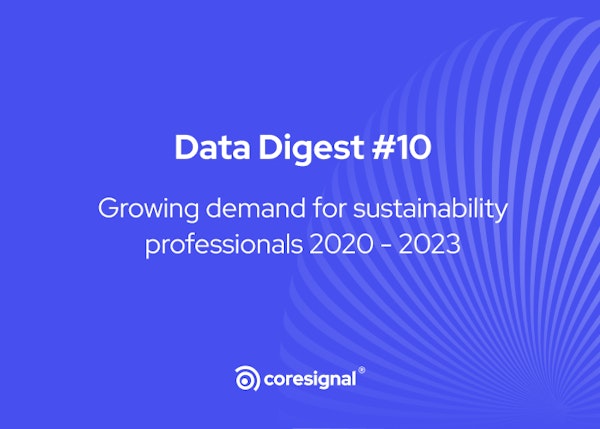Professional network data
Leverage our top B2B datasets
Job posting data
Get access to hundreds of millions of jobs
Employee review data
Get data for employee sentiment analysis
Clean dataNEW
Enhanced professional network data
Employee data
Get data on global talent at scale
Funding data
Discover and analyze funding deals
Firmographic data
Unlock a 360° view of millions of companies
Technographic data
Analyze companies’ tech stacks
BY INDUSTRY
MOST POPULAR USE CASES
Investment
Leveraging web data for informed investing
HR tech
Building or enhancing data-driven HR tech
Sales
Supercharging your lead generation engine
Marketing
Transforming marketing with web data
Market research
Conducting comprehensive market research
Lead enrichment
Use Coresignal’s data for enrichment
Talent analytics
Analyze talent from multiple perspectives
Talent sourcing
Comprehensive talent data for recruitment
Investment analysis
Source deals, evaluate risk and much more
Target market analysis
Build a complete view of the market
Competitive analysis
Identify and analyze competitors
B2B Intent data
Lesser-known ways to find intent signals
BY INDUSTRY
MOST POPULAR USE CASES
Investment
Leveraging web data for informed investing
HR tech
Building or enhancing data-driven HR tech
Sales
Supercharging your lead generation engine
Marketing
Transforming marketing with web data
Market research
Conducting comprehensive market research


Susanne Morris
Updated on March 15, 2024
According to Lever, sourced candidates are approximately twice as efficient and effective as candidates that apply without talent sourcing strategies.
This has pushed companies into leveraging candidate sourcing strategies, software, and tools that utilize a data-driven approach.
This article will explore the importance, benefits, and processes of talent sourcing strategies for recruiters.
What is talent sourcing?
Talent sourcing is the process of discovering, exploring, and interacting with prospective job candidates in order to generate qualified job applicants for a particular position.
Ultimately, successful talent sourcing aims to generate highly-skilled, qualified, and available candidates for a specific position that results in a successful hire.
Why is talent sourcing important?
As we approach a new era of work that involves predicting workforce trends, evaluating human capital, and sourcing high-quality candidates from an increasing talent pool, companies are realizing the importance of a successful talent sourcing strategy.
Further, the quality of talent companies employ is a direct indicator of financial success, projected company growth, and brand health.
Benefits of leveraging talent sourcing
Expanding on the above-mentioned talent sourcing use cases, there are various benefits talent sourcing data provides to companies.
For instance, in a recent study of 250,000 hires by the National Bureau of Economic Research, researchers found that talent sourcing algorithms are able to predict the success of hires more accurately than a majority of hiring managers.
Beyond enhancing the ability to predict the success of hires, talent sourcing also boasts the following benefits:
- Smoother hiring and recruiting process
- A more accurate scope of the existing talent pool
- Increased engagement between a potential candidate and hiring manager
- Reduced hiring and onboarding costs
- Improved sourcing opportunities for hard-to-fill positions
If you're looking for fresh data to enhance your talent sourcing efforts, you've come to the right place. Find the right people for certain positions with our employee data by current title, experience, location, and more.
With this data, you will also be able to find passive candidates who are not actively searching for a new job.
The good thing about passive talent is that they are less likely to have more job interviews elsewhere than active candidates since they’re not actively looking for a new job.
What are talent sourcing strategies and best practices?
As mentioned previously, talent sourcing involves a variety of processes that must work together seamlessly to generate highly qualified candidates in a saturated arena of prospective job candidates.
Over the years, the talent recruitment process has expanded from simply advertising job openings to data-driven methods involving social media, algorithms, and talent sourcing software.
Let’s take a look at the variety of strategies recruiters, HR professionals, and talent sourcers leverage to discover high-quality candidates.
1. Talent sourcing software
As mentioned previously, talent sourcing tools and software, such as the applicant tracking system (ATS), which typically employs and leverages algorithms, are beginning to outperform hiring managers when it comes to predicting a successful hire.
Likewise, recruiting software is able to generate positive hiring results through automated job postings, scheduling, and filtering options.
Some talent sourcing software is able to provide predictive insights by filtering data from candidates from a variety of sources, not just resumes or submitted applications.
This is a good option for companies that are rapidly expanding and looking to streamline their hiring process.
2. Professional social networking websites
As the influences of social media spill into professional settings, talent sourcers and hiring managers are turning primarily to professional social networking websites such as Linkedin, Behance, GitHub, and more.
For instance, a recent CareerBuilder study found that more than the majority of employers utilize social media sites for talent sourcing and recruiting.
Professional social media sites provide recruiters with more detailed information about potential candidates that might get overlooked in resumes, such as personal interests, education, and certifications.
3. Job boards and platforms
In addition to professional social networking sites, job boards and platforms are other successful tools for talent sourcers.
Some examples include Glassdoor, Indeed, ZipRecruiter, and even Craigslist.
Job boards are beneficial for companies looking to fill niche positions in specific industries, as they allow recruiters and candidates to search and filter through positions that match unique keywords and advanced filters.
Also, studying the market could be beneficial. The job market is a dynamic place that continuously changes, therefore keeping track of the changes is important to always have fresh data and prevent inconsistencies.
4. Job fairs and expos
While this option has seen a decline over the past few years due to global health concerns and travel limitations, career fairs and expos have provided sourcers with opportunities to have high-quality interactions with potential candidates.
Additionally, job seekers are able to utilize fairs and expos to speak directly with recruiters, learn more about their industry, and even discover companies that might not have been on their radar.
Also, it helps recruiters build their employer brand and find top talent at the same time.
5. Internal hires and referrals
Lastly, a key component to successful talent sourcing is internal hires and employee referrals. Internal recruiting and referrals are valued by many companies, as current employees require less onboarding and reduce hiring costs.
Also, referrals from reliable employees indicate that a potential candidate will be a high-quality hire, as there is personal interest in the referred applicant to succeed in the company.

The six steps in the talent sourcing process
In addition to the various strategies companies employ to efficiently source high-quality candidates, it is also essential that companies create and regularly update their entire process of sourcing talent.
A successful talent sourcing process typically follows these six major steps.
1. Planning and budgeting
Before posting the position, hiring teams should have a clear budget and ideal candidate profile for all of the positions they are looking to fill.
This will help clarify the job description, salary expectations, candidate sourcing strategies, and provide structure to the sourcing process.
2. Searching for and sourcing candidates
This step involves employing one or more of the above-mentioned candidate sourcing strategies such as recruiting software, professional social networking sites, job boards and platforms, career fairs, and internal hires.
Many companies utilize multiple sourcing strategies, as it can help speed up the hiring process.
3. Creating a qualified candidates' short-list
After applications have been submitted, resumes have been collected, or software has identified potential candidates, recruiters must then create a candidate shortlist.
A shortlist should include a fair amount of potential candidates, from a variety of different backgrounds to ensure that all aspects of the role are being screened for in the interviewing process.
4. Hiring managers interview and assess potential candidates
This step typically requires the most time in the talent sourcing lifecycle, as interviewees and employers have to coordinate sometimes multiple rounds of interviews.
They check the qualified talent, soft skills, necessary skills, and check the information against the ideal candidate persona.
A recent hiring trend has found that virtual interviews are on the rise and here to stay, at least for first-round interviews, due to the impacts of COVID-19.
5. Hiring and onboarding new talent
Once an offer has been accepted, new talent must be onboarded into the company.
This might include additional company-specific training, general role-based training (such as learning modules), as well as a hefty amount of legal and financial paperwork.
6. Reviews and candidate feedback
It is important to note that the talent sourcing process doesn’t simply end with a successful hire.
In order to become more efficient and effective in the talent sourcing process, employers should ask for feedback from hires about the process, as well as provide feedback requested by qualified applicants that weren’t hired.
This builds trust between the company and new hires, as well as maintains a professional networking connection between the company and highly-qualified rejected candidates.

Sourcing vs. acquisition vs. recruitment
While they all seem to achieve a similar goal, successful hires, talent sourcing, acquisition, and recruiting all have slightly different purposes and definitions.
To start, sourcing, as defined above, is the process of discovering, exploring, and interacting with prospective job candidates in order to generate highly qualified job applicants.
This differs from recruiting as job recruiting is defined as the conversion of job applicants and candidates into employees.
Connecting the two, talent acquisition is a term that defines the larger process of hiring and filling current and future positions.
Wrapping up
Ultimately, developing an efficient and effective talent sourcing strategy is a key component of a company’s success. The ability to source high-quality candidates and convert successful hires can make or break a company.
In order to stay ahead of the competition and establish a highly efficient talent pipeline, companies are turning to data-driven recruiting and sourcing strategies that rely heavily on public web data sources and providers, such as Coresignal.
Frequently asked questions
What makes a good talent sourcer?
In order to be a good talent sourcer, one must be able to conduct and organize vast amounts of research and knowledge, both about prospective candidates and the future employer. By deepening one’s understanding of the company and its candidates, talent sourcers are able to generate the right candidate for a job more effectively.
What does a talent sourcing specialist do?
A talent sourcing specialist’s role is to discover prospective candidates for a variety of positions at a particular company. Typically, companies have internal sourcing specialists within their HR department or they outsource talent sourcing to recruitment agencies.
What is a sourcing tool?
A talent sourcing tool is a software or application that helps talent sourcing teams find new talent, reach untapped talent, or locate candidates for hard-to-fill positions (either due to a supply and demand imbalance or due to highly specialized job requirements.
What are some tips for improving the talent sourcing process?
Some tips include regularly reviewing your hiring process, staying engaged with potential hires and communicating clearly about roles and responsibilities, and providing a clear brand image surrounding company culture, benefits, growth opportunities, and more.
Don’t miss a thing
Subscribe to our monthly newsletter to learn how you can grow your business with public web data.
By providing your email address you agree to receive newsletters from Coresignal. For more information about your data processing, please take a look at our Privacy Policy.

Related articles

Sales & Marketing
10 Most Reliable B2C and B2B Lead Generation Databases
Not all lead databases are created equal. Some are better than others, and knowing how to pick the right one is key. A superior...
Mindaugas Jancis
April 23, 2024

Sales & Marketing
It’s a (Data) Match! Data Matching as a Business Value
With the amount of business data growing, more and more options to categorize it appear, resulting in many datasets....
Mindaugas Jancis
April 9, 2024

Data Analysis
Growing demand for sustainability professionals 2020–2023
Original research about the changes in demand for sustainability specialists throughout 2020–2023....
Coresignal
March 29, 2024